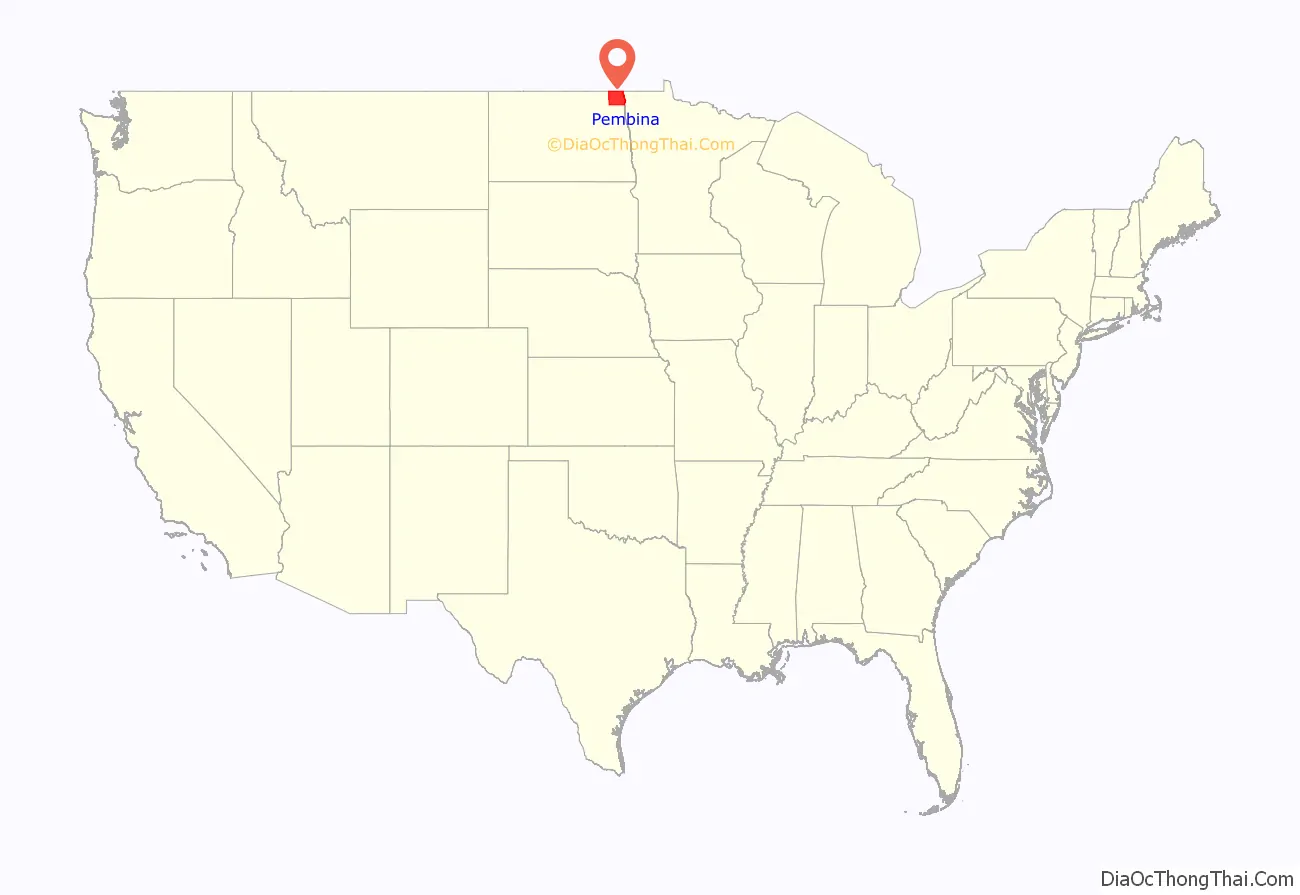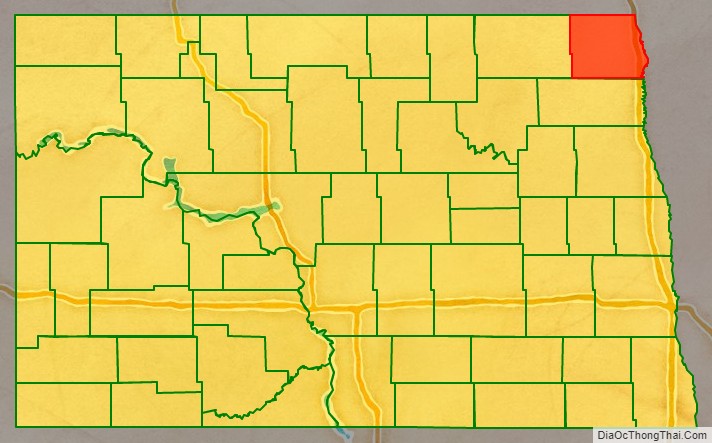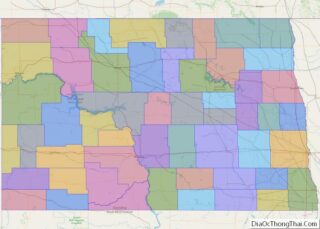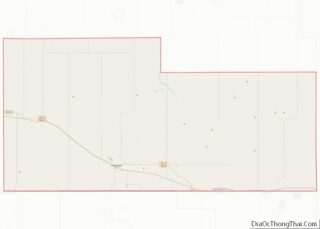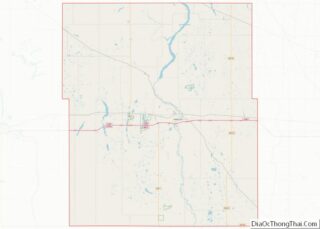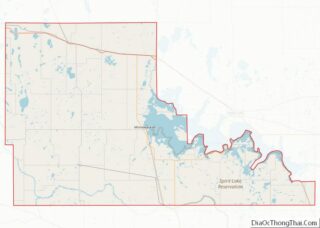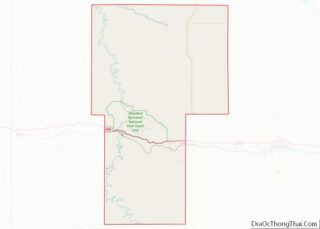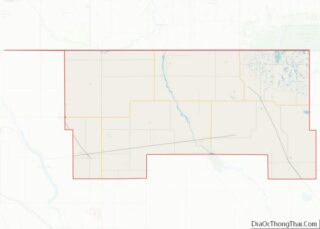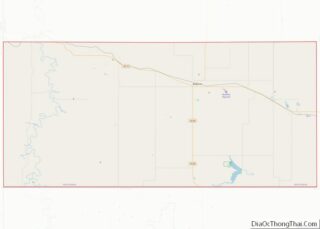Pembina County is a county in the U.S. state of North Dakota. At the 2020 census its population was 6,844. The county seat is Cavalier.
| Name: | Pembina County |
|---|---|
| FIPS code: | 38-067 |
| State: | North Dakota |
| Founded: | 1867 |
| Named for: | a Chippewa term |
| Seat: | Cavalier |
| Largest city: | Cavalier |
| Total Area: | 1,121 sq mi (2,900 km²) |
| Land Area: | 1,119 sq mi (2,900 km²) |
| Total Population: | 6,844 |
| Population Density: | 6.1/sq mi (2.4/km²) |
| Time zone: | UTC−6 (Central) |
| Summer Time Zone (DST): | UTC−5 (CDT) |
| Website: | www.pembinacountynd.gov |
Pembina County location map. Where is Pembina County?
History
For thousands of years, various indigenous peoples inhabited the area along the Pembina and Red rivers. At the time of European contact in the 16th century, the dominant tribes were the Assiniboine and the Lakota (or Sioux, as the French colonists called them). The Ojibwe, also known as Chippewa, a branch of the Anishinaabe-speaking language group, gradually migrated west along both sides of the Great Lakes. They developed a long trading relationship with French trappers and colonists. Throughout the Red River of the North area, French trappers married Native American women, and their descendants continued to hunt and trap. A large mixed-race population developed, recognized as an ethnic First Nations group in Canada called the Métis. The Ojibwe and Métis generally supported the French forces during the Seven Years’ War in the mid-eighteenth century against Great Britain.
With the British defeat of France and takeover of its colonial territory, the Chippewa learned to deal with a new trading culture. Armed with guns by trading and having adopted the horse from the Mandan and Hidatsa, by the end of the eighteenth century the Chippewa had migrated from woodlands to the Great Plains and begun to push the Lakota west before them. By the time of the War of 1812, the Ojibwe allied with the British against the United States, hoping to forestall European-American settlers’ encroaching on their territory. With the settlement of the northern boundary with Canada, the Chippewa within the Dakota Territory were forced to deal with the United States. During the first half of the nineteenth century, the Chippewa had continued conflicts with the Lakota along the Red River, finally pushing them into present-day western North and South Dakota.
Father George Belcourt, a Catholic Jesuit missionary who served them, described their territory in 1849 as the following
The Métis used two-wheeled ox-drawn carts to transport furs to market along the Red River Trails, between what is now Winnipeg, Canada and Mendota or St. Paul, Minnesota. They also used ox-carts to transport food and shelter during extended buffalo hunts.
Over time, the Ojibwe were persuaded to cede much of their land by treaty to the US, which in turn sold it to homesteaders. They moved to relatively small Indian reservations within their earlier territory.
The precursor to Pembina County was a county of the same name in the Minnesota Territory, extending from the Upper Mississippi River to the western boundary of the territory. When Minnesota became a state in 1858, its western boundary was set at the Red River, and the land to its west was unorganized. A new Pembina County was established as part of the Dakota Territory in 1867. At the time it was a large territory, and in 1871 it was expanded to include much of the territory in what is now eastern North Dakota from Canada to the South Dakota border.
The Dakota Territory legislature created Pembina County on January 9, 1867, from previously unorganized territory. Its government was organized on August 12 of that same year. It was named for a Chippewa term for stab or stabbing. Pembina, the oldest European-American settlement in the future state, was the county seat. In 1911 the seat was relocated to Cavalier.
The county boundaries were altered in 1871, 1873, 1881, and 1887. It has retained its present boundaries since 1887. Between 1873 and 1881, eleven new counties were created from Pembina, including Cass County and Grand Forks County. Pembina took its current form in 1887, when Cavalier County was increased in size.
Icelandic State Park is located in Pembina County. The first Icelandic immigrant settlement in present-day North Dakota was in Pembina County in the late 1870s, when a colony of settlers from Iceland moved into the county from the New Iceland homesteads near Lake Winnipeg.
The first Icelandic settlements in what is now North Dakota were established in Pembina County in the late 1870s. Many of the immigrants came from New Iceland near Lake Winnipeg, along with other Icelanders who moved into the area from colonies in Wisconsin. The new settlers lived primarily in the so-called “Icelandic Townships” of Akra, Beaulieu, Gardar, and Thingwalla. The State Historical Society of North Dakota reported fewer than 3 or 4 non-Icelandic families living there in the early 1900s. Evidence of this heritage is found in several township and city names with Icelandic origins. Akra was named after the town of Akranes, near Reykjavík; Gardar was named for Gardar Svavarsson, who was reportedly the first Scandinavian to visit Iceland; and Hallsson was named for an early settler, Johann P. Hallson.
Icelandic State Park was established to preserve evidence of this early pioneer heritage.
Pembina County Road Map
Geography
Pembina County lies at the northeast corner of North Dakota. Its north boundary line abuts the south boundary line of Canada and its east boundary line abuts the west boundary line of the state of Minnesota (across the Red River, which flows northward along the county’s eastern boundary line). The Pembina River flows easterly through the upper portion of the county, discharging into the Red River near the northeast county corner. The Tongue River flows northeasterly through the upper portion of the county, discharging into the Pembina shortly before the Pembina joins the Red River. The county terrain consists of rolling hills, etched by river drainages. The area is devoted to agriculture. The terrain slopes to the east and north; its highest point is on the lower western boundary line, at 1,302 feet (397 m) above sea level. The county has a total area of 1,121 square miles (2,900 km), of which 1,119 square miles (2,900 km) is land and 2.7 square miles (7.0 km) (0.2%) is water. The lowest point in the state of North Dakota is located on the Red River of the North in Pembina Township in Pembina County, where it flows out of North Dakota and into the Canada–US border of Manitoba.
Major highways
- Interstate 29
- U.S. Highway 81
- North Dakota Highway 5
- North Dakota Highway 18
- North Dakota Highway 32
- North Dakota Highway 44
- North Dakota Highway 66
- North Dakota Highway 89
Adjacent counties and rural municipalities
- Rural Municipality of Stanley, Manitoba, Canada – northwest
- Municipality of Rhineland, Manitoba, Canada – north
- Rural Municipality of Montcalm, Manitoba, Canada – northeast
- Kittson County, Minnesota – east
- Marshall County, Minnesota – southeast
- Walsh County – south
- Cavalier County – west
Protected areas
- Frost Fire Ski and Snow Board Area
- Houghton National Wildlife Management Area
- Icelandic State Park
- Juhl National Wildlife Management Area
- McDonald National Wildlife Management Area
- Pembina Gorge State Recreation Area
- Pembina Prairie National Wildlife Management Area
- Tetrault State Forest (part)
